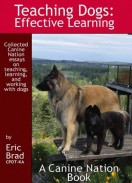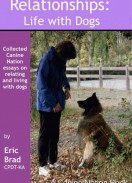 When we got our dog Tiramisu she was just 11 weeks old. Two years earlier we had discovered “positive training”; a way of training dogs using rewards instead of punishment and behavioural science instead of folklore. This proactive approach to training had already rescued a damaged relationship with our dog Vince so I was very keen to see how well it could work with a new puppy. I must admit, I was a little skeptical.
When we got our dog Tiramisu she was just 11 weeks old. Two years earlier we had discovered “positive training”; a way of training dogs using rewards instead of punishment and behavioural science instead of folklore. This proactive approach to training had already rescued a damaged relationship with our dog Vince so I was very keen to see how well it could work with a new puppy. I must admit, I was a little skeptical.
This positive approach to training was very different from the way I used to think about dog training. I decided that it would be a good test to just “do what the books said” in raising my new puppy using this new “positive training” and behavioural science. I would do all of it exactly as described in books and videos by the experts. But I would walk away from it the minute this kind of training didn’t work as advertised.
More than 14 years later, I’m still at it. I’m still using everything I’ve learned and I’m still learning. Not only does this kind of training work, it works in ways I never expected. As a young dog, Tiramisu learned behaviours incredibly quickly. She became an enthusiastic partner in the sport of Dog Agility and even earned a pile of ribbons and titles. Even after being diagnosed with hypothyroidism at 8 years old, she recovered so well from treatment that she went on to earn several more agility championship titles. She continued to play at the top levels of agility until she was 12. I credit all of that success to what I’ve learned about canine behaviour and modern reward-based training.
Time takes its toll and we retired her from competition before she turned 13. Her joints were getting sore and she wasn’t enjoying it anymore. As Tira has moved into old age, she has lost some hearing and some sight. But her mind remains remarkably sharp. So now I am seeing some wonderful and unexpected benefits of this kind of behavioural training as Tira deals with old age as she nears 15.
Vestibular Events
A major turning point in Tiramisu’s health happened when she was 13. On a June night, my wife and I were awakened by a loud thumping noise next to our bed. My wife quickly told me that Tiramisu couldn’t stand up. Her back end didn’t seem to be working and she was clearly panicked. We quickly carried Tira out into the living room and helped her to stand. Her heart was hammering and she was trembling. She clearly didn’t know how to cope with whatever was happening. But within an hour, she was taking treats and seemed to have regained her balance. It took a couple more hours but she settled down and got back to normal.
The next morning, our research suggested that Tiramisu had experienced a “vestibular event” not uncommon in older dogs. We were relieved that vestibular events were not life-threatening but it sure scared Tira. Typically a dog will experience only one or two of these in a lifetime. We weren’t so lucky. Over the next 8 months, Tira would have 5 more of these events, each lasting longer and longer. The last two episodes lasted for days, not hours.
 Through it all, we noticed a remarkable pattern. These vestibular events are much like vertigo in humans. There is a spinning sensation that is evident by the flicking of the dog’s eyes as they try to keep up with the dizziness. Even though the dizziness of that last episode went on for days, Tira showed none of the fear or panic of that first very brief episode. It seemed to us that each time one of these events happened, Tira was better and better at coping. During her last event, Tira seemed determined to get on with life despite the spinning and nausea. She would eat her regular meals, stumble as best she could to get out and do her business, and even attempted to play a few times.
Through it all, we noticed a remarkable pattern. These vestibular events are much like vertigo in humans. There is a spinning sensation that is evident by the flicking of the dog’s eyes as they try to keep up with the dizziness. Even though the dizziness of that last episode went on for days, Tira showed none of the fear or panic of that first very brief episode. It seemed to us that each time one of these events happened, Tira was better and better at coping. During her last event, Tira seemed determined to get on with life despite the spinning and nausea. She would eat her regular meals, stumble as best she could to get out and do her business, and even attempted to play a few times.
I attribute her resilience and adaptability to the positive training we had used throughout her life. Many times we had asked her to adapt to new behaviours, new environments, new situations. In each case, we never asked too much and we always rewarded her efforts to cope. We can’t know for certain that it was just the training since none of our other dogs have had vestibular events. But it seems to us that all of that training we did with Tira gave her a capacity for learning and adapting to new life situations quickly and easily. Just as she had adapted to all the different places and things we had exposed her to throughout her life, Tira seemed determined to adapt to this new challenge as well.
Losing sight and hearing
The vestibular events left Tiramisu with pretty significant balance issues. This was complicated by worsening arthritis in her joints. On top of that, Tira was also losing her hearing and eyesight. In the last year, we have discovered that she has difficulty hearing any but the loudest or sharpest sounds. That means all of those carefully taught verbal cues are not helping us manage her. And her failing sight means that she relies much more heavily on her nose to find her treats, her medications, and her meals.
It was a delightful surprise that even with her diminished sight, Tira would still respond to many of the visual cues we had practised so many times in Dog Agility. The arm sweeps needed to be bigger and I needed to be sure she was looking at me, but I find that it is quite easy to tell her where I need her to go with a wave or a turn of my body. She happily complies.
The biggest challenge for us is remembering that Tira needs this extra assistance. So long as we take care to make sure she is getting our signals, Tira will move to where we need her or come along with us. It just wasn’t that easy letting go of the verbal cues we had trained and used for years. But I’m grateful that we have those visual cues to help us out.
The Cognitive Conundrum
One of our biggest concerns with Tira as she ages is her mind. The older she gets, the greater the likelihood that canine dementia or Canine Cognitive Disorder sets in. Trainer and author Eileen Anderson has an excellent book, Remember Me?, covering canine dementia in detail and in it she relates her own story. Eileen also talks about her own challenges with her aging dog in this wonderful essay.
 This is where our science-based training has really paid off. After years of teaching my dog lots of behaviours and “tricks”, they have become an effective barometer for Tira’s mental state. I can test her memory by giving her a visual cue to see if she can still remember what to do. I can observe her motor skills based on the behaviour I am asking for. And perhaps most importantly, I can assess the enthusiasm she still has for engaging with me and, by extension, her interest in life and living.
This is where our science-based training has really paid off. After years of teaching my dog lots of behaviours and “tricks”, they have become an effective barometer for Tira’s mental state. I can test her memory by giving her a visual cue to see if she can still remember what to do. I can observe her motor skills based on the behaviour I am asking for. And perhaps most importantly, I can assess the enthusiasm she still has for engaging with me and, by extension, her interest in life and living.
One of the great gifts of Mark and Reward training is that it produces “durable” behaviours; behaviours that are easy for the dog to remember even if they haven’t been practised for months or even years. To be able to look down at Tiramisu and give her the hand signal to turn in a circle shows me that she remembers how to do that behaviour. But it also shows me how well she is moving or if she is in pain. And it tells me something about her eagerness to get that reward and her enjoyment of life.
Watching carefully
Tiramisu has mostly good days but some bad days as well. We’ve put down a few new rugs on some slippery floor to help her keep her footing. But we are a multi-dog household. One of our most important jobs is helping Tira with the unpredictable movements of our other two dogs. Rizzo, who is now 8 years old, has grown up with Tira and has been mostly respectful of her space. But our youngest puppy, Six, is much more exuberant (and clueless) and needs to be managed more closely.
There is another aspect of having an aging dog in a multi-dog household. We need to watch the other dogs around Tira because dogs seem to have a sense when other dogs in their social group are in decline or are seriously ill. The younger dogs in the house can come to see these older or sicker dogs as an “other.” Something to be shunned or even attacked. Dog trainer and good friend Blanche Axton explains this very well in her essay The Not Dogs.
Fortunately, watching my dogs has become second nature to me and my wife. This is another unexpected gift from Mark and Reward training. From my very first days learning this kind of training with Tiramisu all those years ago, I learned that it was important to watch the dog to see if they were offering the behaviour I wanted to reward. That process of monitoring her behaviour in training seems to have spilled over into everyday life. Just as I would watch to see if she were moving in the direction I wanted in training, I could also see changes in her mood based on her responses. Now as she ages, I can also see small changes in her day to day behaviour. Is she having trouble with stairs? Is she reluctant to eat? Is she in pain or just losing her balance? I can only know these things if I watch and take it all in. Mark and Reward training taught me to always be watching.
Aging Gracefully

I have learned a great deal from Tiramisu over the years. All of the books and seminars may have taught me how to do this positive training but it is Tiramisu herself that teaches me how it works. It seems you can’t really understand this kind of training unless you do it as a partner to your dog. Tira has taught me many great lessons about using Mark and Reward to best effect. Perhaps the greatest lesson is that growing old is a process and that she can adapt to it with grace and courage. She carries with her all of the learning of a lifetime and all of the skill and confidence that comes with that.
She is an amazing dog and I will treasure her for as long as she is with us. And for many years after.
Until next time, enjoy every moment with your dogs!
Be sure to check out our Canine Nation ebooks available at Dogwise, Amazon, iTunes, Google Play Books, and other online book sellers . Join our conversation on Facebook in the Canine Nation Forum!
These Canine Nation ebooks are now available –
Photo credits –
All images copyright Eric Brad 2016-2018





“Perhaps the greatest lesson is that growing old is a process and that she can adapt to it with grace and courage.”
Would that we (I) as humans could do likewise. I still remember meeting her as a puppy. Seems so long ago.
As your publisher, I want to thank you for your great writing Eric. For your honesty, your patience. Your adherence to facts. Your quest for knowledge and your appetite for it. Your ability to learn from it and make it practical for your readers. Your tolerance for other opinions regardless of the spirit in which they were expressed. Your devotion to your fur kids.
As your friend … I say this. You have made a difference in my life, and I know you have done the same in the lives of others.
You are an encouragement to me Eric … yes, in my relationship with my dog Jazz, but much more so, in my life as a human.
Thank you Eric!
Now … what’s next 😉
Yer bro
Gileeeeeeeeeeeeeeeee